Konstruktionismus constructionism
 Synonyme
Synonyme
Konstruktionismus, constructionism
 Definitionen
Definitionen
Put simply, this means that children learn most effectively when they are doing
things rather than just sitting and listening.
Von Bryan Appleyard im Text Why Microsoft and Intel tried to kill the XO $100 laptop (2008)  Constructionism proposes that technologies, computers as well as tangible manipulatives such as robotics, are powerful for educational purposes when used for supporting the design, the construction, and the programming of personally and epistemologically meaningful projects (Papert, 1980; Resnick, Bruckman, & Martin, 1996a).
Constructionism proposes that technologies, computers as well as tangible manipulatives such as robotics, are powerful for educational purposes when used for supporting the design, the construction, and the programming of personally and epistemologically meaningful projects (Papert, 1980; Resnick, Bruckman, & Martin, 1996a).Constructionism is an approach to learning that emphasizes
the production of public artifacts as a way of engaging with
and learning about the world. From its roots in the logo
programming language for children, to its inspiration of
projects like One Laptop Per Child (OLPC),
constructionism has had a profound effect on the way many
researchers think about technology and education.
Von Andrea Forte, Amy Bruckman im Konferenz-Band WikiSym 2007 (2007) im Text Constructing Text  Der Konstruktionismus ist eine aus der Erkenntnistheorie des Konstruktivismus abgeleitete Lerntheorie, die davon ausgeht, dass beim Bauen/Erstellen/Erschaffen von Objekten Lernen besonders effizient ist, weil Lernende einerseits intrinsisch motiviert sind, etwas Eigenständiges zu gestalten und weil man andererseits gewisse der Konstruktion innewohnende Prinzipien begriffen haben muss, um etwas Funktionierendes bauen zu können.
Der Konstruktionismus ist eine aus der Erkenntnistheorie des Konstruktivismus abgeleitete Lerntheorie, die davon ausgeht, dass beim Bauen/Erstellen/Erschaffen von Objekten Lernen besonders effizient ist, weil Lernende einerseits intrinsisch motiviert sind, etwas Eigenständiges zu gestalten und weil man andererseits gewisse der Konstruktion innewohnende Prinzipien begriffen haben muss, um etwas Funktionierendes bauen zu können. An extension of constructivist theories of learning, associated primarily with the work of Seymour Papert. Constructionism describes how learning takes place through the exploratory building of objects that are themselves capable of doing something. By building an object and then manipulating it to do something, individuals are able to learn from the process of thinking about how to get something else to think. Constructionists talk of supporting individuals’ conversations with artefacts, thereby framing technology as a tool to learn with rather than learn from.
An extension of constructivist theories of learning, associated primarily with the work of Seymour Papert. Constructionism describes how learning takes place through the exploratory building of objects that are themselves capable of doing something. By building an object and then manipulating it to do something, individuals are able to learn from the process of thinking about how to get something else to think. Constructionists talk of supporting individuals’ conversations with artefacts, thereby framing technology as a tool to learn with rather than learn from. Seymour’s approach built on what he had learned from Piaget,
viewing children as active constructors, not passive recipients, of
knowledge. Seymour went a step further, arguing that children construct
knowledge most effectively when they are actively involved
in constructing things in the world — that is, when they are makers
of things. Seymour called his approach constructionism, because it brings together two types of construction: As children construct things in the world, they construct new ideas in their heads, which motivates them to construct new things in the world, and on and on, in a never-ending spiral of learning.
Seymour’s approach built on what he had learned from Piaget,
viewing children as active constructors, not passive recipients, of
knowledge. Seymour went a step further, arguing that children construct
knowledge most effectively when they are actively involved
in constructing things in the world — that is, when they are makers
of things. Seymour called his approach constructionism, because it brings together two types of construction: As children construct things in the world, they construct new ideas in their heads, which motivates them to construct new things in the world, and on and on, in a never-ending spiral of learning. Constructionism involves two types of construction. First, it asserts that learning is an active process, in which people actively construct knowledge from their experiences in the world. (This idea is based on the constructivist theories of Jean Plaget.) To this, constructionism adds the idea that people construct new knowledge with particular effectiveness when they are engaged in constructing products that are personally meaningful. They might be constructing sand casdes, LEGO machines, or computer programs. What's important is that they are actively engaged in creating something that is meaningful to themselves or to others around them.
Constructionism involves two types of construction. First, it asserts that learning is an active process, in which people actively construct knowledge from their experiences in the world. (This idea is based on the constructivist theories of Jean Plaget.) To this, constructionism adds the idea that people construct new knowledge with particular effectiveness when they are engaged in constructing products that are personally meaningful. They might be constructing sand casdes, LEGO machines, or computer programs. What's important is that they are actively engaged in creating something that is meaningful to themselves or to others around them. The term "constructionism" first coined by Seymour Papert, involves two types
of construction. First, it asserts that learning is an active process, in which people actively
construct knowledge from their experiences in the world. (This idea is based on the
theories of Jean Piaget.) To this, constructionism adds the idea that people construct new knowledge with particular effectiveness when they are engaged in constructing personally meaningful products. They might be constructing sand castles, LEGO machines, computer programs, or virtual objects. What's important is that they are actively engaged in creating something that is meaningful to themselves and to others around them.
The term "constructionism" first coined by Seymour Papert, involves two types
of construction. First, it asserts that learning is an active process, in which people actively
construct knowledge from their experiences in the world. (This idea is based on the
theories of Jean Piaget.) To this, constructionism adds the idea that people construct new knowledge with particular effectiveness when they are engaged in constructing personally meaningful products. They might be constructing sand castles, LEGO machines, computer programs, or virtual objects. What's important is that they are actively engaged in creating something that is meaningful to themselves and to others around them. Seymour Papert entwickelte die Vorstellung vom "Konstruktionistischen Lernen" Paperts Ansatz basiert auf dem Verständnis des Konstruktivismus, das Lernen als aktiven Aufbau von Wissensstrukturen begreift. Wissen wird durch die Lernenden hergestellt, nicht von den Lehrenden vermittelt. Mit dem Konstruktionismus wird dies erweitert um die Vorstellung, dass dieser Aufbau von Wissensstrukturen dann besonders gut gelingen kann, wenn die Lernenden selbst etwas herstellen, konstruieren, ein äußerlich sichtbares, wahrnehmbares Objekt. Diese Objekte bezeichnet Papert als "Objects-to-think-with" Kinder sind dabei als aktive, ihr Lernen selbst organisierende und konstruierende Subjekte zu verstehen.
Seymour Papert entwickelte die Vorstellung vom "Konstruktionistischen Lernen" Paperts Ansatz basiert auf dem Verständnis des Konstruktivismus, das Lernen als aktiven Aufbau von Wissensstrukturen begreift. Wissen wird durch die Lernenden hergestellt, nicht von den Lehrenden vermittelt. Mit dem Konstruktionismus wird dies erweitert um die Vorstellung, dass dieser Aufbau von Wissensstrukturen dann besonders gut gelingen kann, wenn die Lernenden selbst etwas herstellen, konstruieren, ein äußerlich sichtbares, wahrnehmbares Objekt. Diese Objekte bezeichnet Papert als "Objects-to-think-with" Kinder sind dabei als aktive, ihr Lernen selbst organisierende und konstruierende Subjekte zu verstehen. Constructionism [Papert, 1991] is both a theory of learning and a strategy for education. Constructionism is
based on two types of "construction." First, it asserts that learning is an active process, in which people actively construct knowledge from their experiences in the world. People don't get ideas; they make them. (This idea is based on the constructivist theories of Jean Piaget.) To this, constructionism adds the idea that people construct new knowledge with particular effectiveness when they are engaged in constructing personally-meaningful products. They might be constructing sand castles, poems, LEG0 machines [Resnick, 1993], or computer programs [Harel, 1991; Kafai, 1995]. What's important is that they are actively engaged in creating something that is meaningful to themselves or to others around them.
Constructionism [Papert, 1991] is both a theory of learning and a strategy for education. Constructionism is
based on two types of "construction." First, it asserts that learning is an active process, in which people actively construct knowledge from their experiences in the world. People don't get ideas; they make them. (This idea is based on the constructivist theories of Jean Piaget.) To this, constructionism adds the idea that people construct new knowledge with particular effectiveness when they are engaged in constructing personally-meaningful products. They might be constructing sand castles, poems, LEG0 machines [Resnick, 1993], or computer programs [Harel, 1991; Kafai, 1995]. What's important is that they are actively engaged in creating something that is meaningful to themselves or to others around them. Bemerkungen
Bemerkungen
 The maker movement is terribly exciting in the ways it celebrates the virtues of constructionism, even if the advocates of learning by making have no formal knowledge of the theory underlying their passions.
The maker movement is terribly exciting in the ways it celebrates the virtues of constructionism, even if the advocates of learning by making have no formal knowledge of the theory underlying their passions. We believe that “constructionism,” a similar-sounding term coined by Seymour Papert, is the learning theory that most strongly resonates within the maker movement and should be taken seriously by anyone investigating classroom making.
We believe that “constructionism,” a similar-sounding term coined by Seymour Papert, is the learning theory that most strongly resonates within the maker movement and should be taken seriously by anyone investigating classroom making.Constructionism as a way
of thinking about education carries with it an ideology of
empowerment and choice. Ideally, learners choose what it
is they want to do and learn through the process of
engaging in open-ended, unstructured, playful but
productive construction activities.
Von Andrea Forte, Amy Bruckman im Konferenz-Band WikiSym 2007 (2007) im Text Constructing Text  Constructionism
is not constructivism, as Piaget never
intended his theory of knowledge development
to be a theory of learning and teaching;
nor is constructionist learning simply discovery
learning and thus opposed to any
forms of instruction; and last, in constructionism,
people and not computers are seen
as the driving force for educational change.
Constructionism
is not constructivism, as Piaget never
intended his theory of knowledge development
to be a theory of learning and teaching;
nor is constructionist learning simply discovery
learning and thus opposed to any
forms of instruction; and last, in constructionism,
people and not computers are seen
as the driving force for educational change. Educational designers cannot and
should not control exactly what or when or
how students will learn. The point is not to
make a precise blueprint. Rather, practitioners
of constructional design can only create
"spaces" of possible activities and experiences.
What we can do as constructional designers is
to try to make those spaces dense with personal
and epistemological connections-making
it more likely for learners to find regions
that are both appealing and intellectually
interesting.
Educational designers cannot and
should not control exactly what or when or
how students will learn. The point is not to
make a precise blueprint. Rather, practitioners
of constructional design can only create
"spaces" of possible activities and experiences.
What we can do as constructional designers is
to try to make those spaces dense with personal
and epistemological connections-making
it more likely for learners to find regions
that are both appealing and intellectually
interesting.
 The general notion of constructionism (Papert’s re-phrasing of constructivism) was
that by actively trying to create something concrete (either physical or computational)
to solve a problem the learner naturally had to make their thinking – that which was
implicit – explicit. Furthermore, having to make something concrete enabled the
learner to ‘see’ the results of their thinking, whether it worked, and whether it needed
revision (debugging). Papert argued that such a process fostered the development
of metacognitive skills in the domain.
The general notion of constructionism (Papert’s re-phrasing of constructivism) was
that by actively trying to create something concrete (either physical or computational)
to solve a problem the learner naturally had to make their thinking – that which was
implicit – explicit. Furthermore, having to make something concrete enabled the
learner to ‘see’ the results of their thinking, whether it worked, and whether it needed
revision (debugging). Papert argued that such a process fostered the development
of metacognitive skills in the domain. Constructivism, the theory of learning advanced in Mindstorms, had its roots in
the work of Piaget. One of Piaget's best known contributions to developmental
psychology was his stage theory of learning. By this theory, the child begins in the
sensorimotor stage, advances in elementary school to the stage of concrete operations,
and eventually moves on to the formal stage. In The Children's Machine,
however, Papert calls Piaget 's stage theory of development into question. He
contends that the concrete thinking of the bricoleur or bricoleuse, though deprecated
in school settings, appears in the thought of even the most sophisticated adults.
Theories of learning, he argues therefore, should not focus exclusively on the
acquisition of formal reasoning skills, but also on the development of advanced
skills for concrete reasoning.
Constructivism, the theory of learning advanced in Mindstorms, had its roots in
the work of Piaget. One of Piaget's best known contributions to developmental
psychology was his stage theory of learning. By this theory, the child begins in the
sensorimotor stage, advances in elementary school to the stage of concrete operations,
and eventually moves on to the formal stage. In The Children's Machine,
however, Papert calls Piaget 's stage theory of development into question. He
contends that the concrete thinking of the bricoleur or bricoleuse, though deprecated
in school settings, appears in the thought of even the most sophisticated adults.
Theories of learning, he argues therefore, should not focus exclusively on the
acquisition of formal reasoning skills, but also on the development of advanced
skills for concrete reasoning. The constructionist approach goes beyond hands-on in a variety of ways. In constructionist activities, students do not simply manipulate physical objects, they constuct personally meaningful products. It is easy to see how 'constructing" is better than merely "manipulating": children are sure to learn more by buildmg and programming their own robots rather than manipulating store-bought, fully assembled robots. But there is a deeper point here. Children are likely to become intellectually engaged only if they are constructing personally meaningful things. When students design and construct products that are meaningful to themselves (or to others around them), they tend to approach their work with a sense of caring and interest that is missing in most school activities. In doing so, students are more likely to explore, and to make deep "connections" with, the mathematical and scientific concepts that underlie the activities. Building and programming a merry-go-round is based on the same underlying principles as building and programming a classic robot - but for a child who cares more about merry-go-rounds than robots, the merry-go-round project offers a much richer learning experience.
The constructionist approach goes beyond hands-on in a variety of ways. In constructionist activities, students do not simply manipulate physical objects, they constuct personally meaningful products. It is easy to see how 'constructing" is better than merely "manipulating": children are sure to learn more by buildmg and programming their own robots rather than manipulating store-bought, fully assembled robots. But there is a deeper point here. Children are likely to become intellectually engaged only if they are constructing personally meaningful things. When students design and construct products that are meaningful to themselves (or to others around them), they tend to approach their work with a sense of caring and interest that is missing in most school activities. In doing so, students are more likely to explore, and to make deep "connections" with, the mathematical and scientific concepts that underlie the activities. Building and programming a merry-go-round is based on the same underlying principles as building and programming a classic robot - but for a child who cares more about merry-go-rounds than robots, the merry-go-round project offers a much richer learning experience. Verwandte Objeke
Verwandte Objeke
 Verwandte Begriffe (co-word occurance) |  LOGO (Programmiersprache) LOGO (Programmiersprache) LOGO (programming language)(0.03) LOGO (programming language)(0.03) |
 Relevante Personen
Relevante Personen
 Häufig erwähnende Personen
Häufig erwähnende Personen
 Häufig co-zitierte Personen
Häufig co-zitierte Personen
 Statistisches Begriffsnetz
Statistisches Begriffsnetz 
 9 Vorträge von Beat mit Bezug
9 Vorträge von Beat mit Bezug
- One Notebook per Child (OLPC)
Der 100$ Laptop auch für die Schweiz?
IBM Solution Lab, Rüschlikon, 25.02.2008

- Wie das Web 2.0 die (politische) Bildung in Bewegung bringen kann
Referat an der Tagung pb21.de: Web 2.0 in der politischen Bildung
Hattingen, 10.02.2010
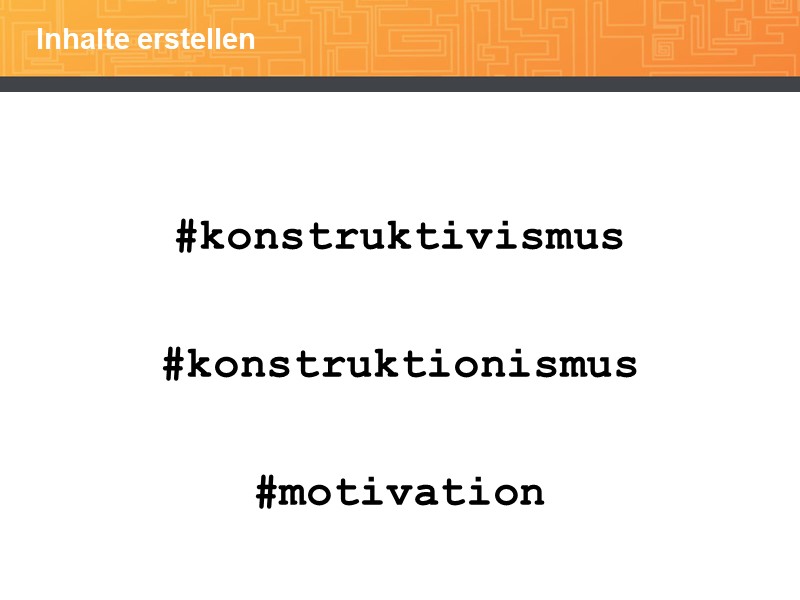
- Informatische Bildung auf der Primarstufe: Bildungswert und Grenzen
PH FHNW, 01.03.2013
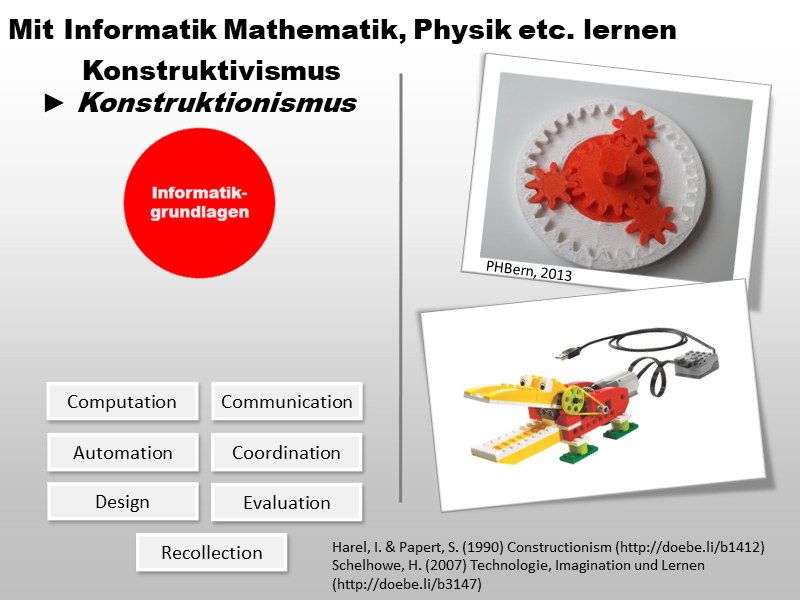
- Mehr als 0 und 1: Schule in einer digitalisierten Welt
Pädagogische Hochschule Schwyz, 20.11.2014
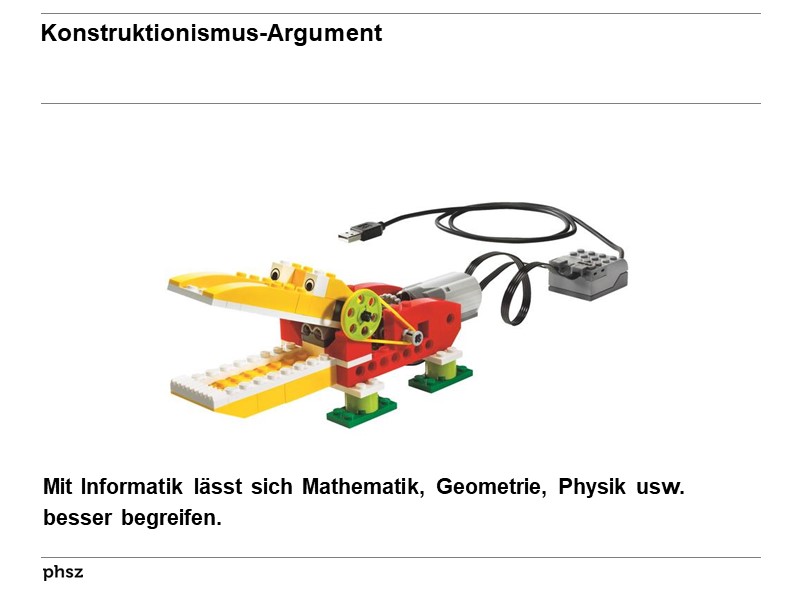
- Der Leitmedienwechsel und die Bildung
Podium Interface, Hochschule für Technik
FHNW, Windisch, 08.12.2014

- Informatik in der Volksschule: Was - Warum - Wie?
Einstiegsvortrag Kaderkurs "Informatische Bildung" der OSKIN
PH Zug, 14.01.2015
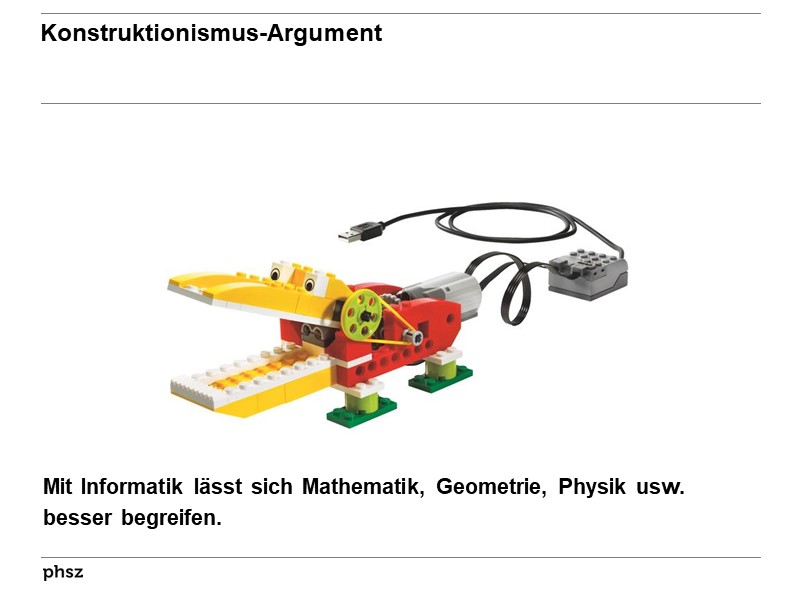
- We are all excited - but why?
Opening Keynote (Video of the keynote together with Mitch Resnick)
Scratch Conference, Amsterdam, 13.08.2015
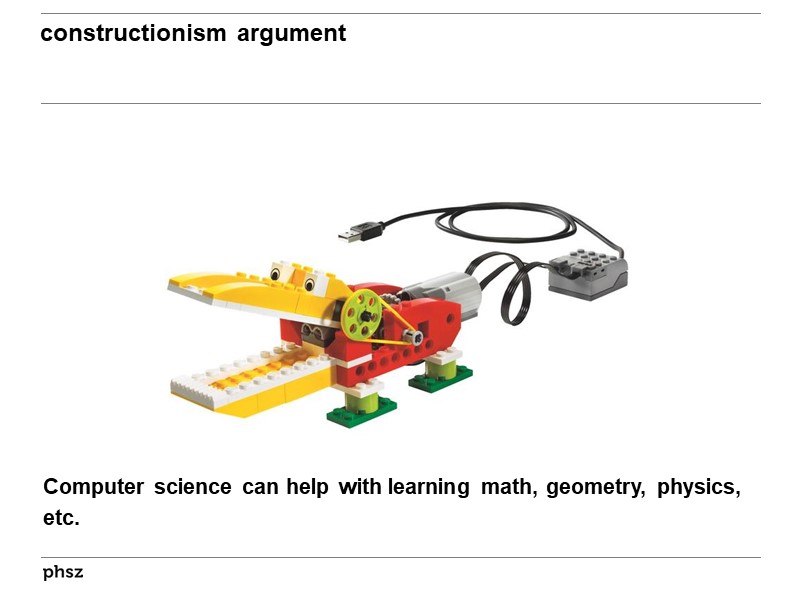
- i-factory school kit 2016
Verkehrshaus der Schweiz, Luzern, 30.03.2016
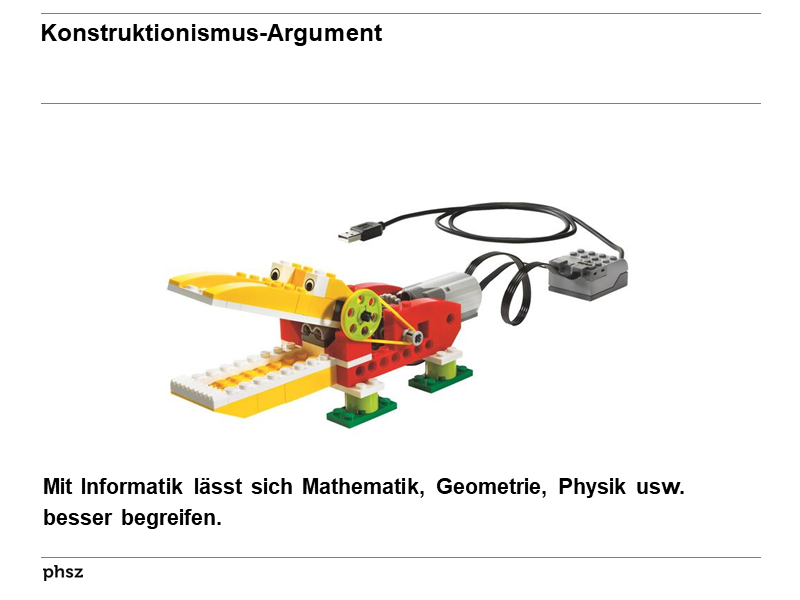
- Survival Guide für Fachdidaktik MINT in der Primarschule
Eva Marinus & Beat Döbeli Honegger
ETH MINTerlink-Seminar, 18.02.2022

 4 Einträge in Beats Blog
4 Einträge in Beats Blog
 Zitationsgraph
Zitationsgraph
 Zitationsgraph (Beta-Test mit vis.js)
Zitationsgraph (Beta-Test mit vis.js)
 Zeitleiste
Zeitleiste
 106 Erwähnungen
106 Erwähnungen 
- Piaget’s Constructivism, Papert’s Constructionism - What’s the difference? (Edith Ackermann)


- Ghost in the Machine - Seymour Papert on How Computers Fundamentally Change the Way Kids Learn (Interview) (Seymour Papert, Dietrich Schwanitz)

- Computers as Mindtools for Engaging Critical Thinking and Representing Knowledge (David H. Jonassen)


- Doing IT differently - Digital pedagogy for digital learning (Johannes C Cronjé)
- Neural Network Construction Practices in Elementary School (Gilad Shamir, Ilya Levin)


- Computerization and Controversy - Value conflicts and social choices

- Constructionism (Idit Harel, Seymour Papert) (1990)
- Revolution des Lernens - Kinder, Computer, Schule in einer digitalen Welt (Seymour Papert) (1993)


- 7. Instruktionismus versus Konstruktionismus

- 7. Instruktionismus versus Konstruktionismus
- Turtles, Termites, and Traffic Jams - Explorations in Massively Parallel Microworlds (Complex Adaptive Systems) (Mitchel Resnick) (1994)


- MOOSE Crossing - Creating a Learning Culture. (Amy Bruckman) (1994)


- Total Digital - Die Welt zwischen 0 und 1 oder Die Zukunft der Kommunikation (Nicholas Negroponte) (1995)


- Information und Lernen mit Multimedia (Ludwig J. Issing, Paul Klimsa) (1995)

- 20. Besseres Lernen durch Computer in der Schule? - Nutzungsbeispiele und Einsatzbedingungen (Heike Schaumburg)
- Minds in Play - Computer Game Design As A Context for Children's Learning (Yasmin B. Kafai) (1995)


- 1. Learning Through Design - Review of Theory and Research Issues

- 1. Learning Through Design - Review of Theory and Research Issues
- Distributed Constructionism (Mitchel Resnick) (1996)


- Pianos, not Stereos - Creating computational construction kits (Mitchel Resnick, Amy Bruckman, Fred Martin) (1996)


- Grundlagen hypermedialer Lernsysteme - Theorie - Didaktik - Design (Rolf Schulmeister) (1996)



- Constructionism in Practice - Designing, Thinking, and Learning in a Digital World (Yasmin B. Kafai, Mitchel Resnick) (1996)

- Introduction

- 9. The MediaMOO Project - Constructionism and Professional Community (Amy Bruckman, Mitchel Resnick) (1995)


- Introduction
- The Journal of the Learning Sciences 6(4) (1997)
- Computers as Mindtools for Engaging Learners in Critical Thinking (David H. Jonassen, Chad Carr, Hsiu-Ping Yueh) (1998)

- Didaktisches Interaktions- und Informationsdesign - Systematische modellgeleitete Gestaltung von virtuellen Studienlandschaften (Hilko Donker) (2002)


- Internet in der Grundschule - Medienpädagogische und -didaktische Grundlagen (Stephan Wöckel) (2002)

- Medienkompetenz - Eine Bestandsaufnahme und Vorüberlegungen zu einem systhemtheoretischen Rahmenkonzept (Harald Gapski) (2002)
- Medienkompetenz als Schlüsselqualifikation (Peter Glotz)
- Learning to Solve Problems with Technology (2nd ed.) - A Constructivist Perspective (David H. Jonassen, Jane Howland, Joi Moore, Rose M. Marra) (2003)


- 3. Learning From the Internet - Information to Knowledge Through Inquiry (Jane Howland, David H. Jonassen, Rose M. Marra, Joi Moore)
- Theory of Computation as a Vehicle for Teaching Fundamental Concepts of Computer Science - Thesis 15035, ETH Zürich, D-INFK, May 2003 (Raimond Reichert) (2003)



- Guidelines for Learning/Teaching/Tutoring in a Mobile Environment (C. O’Malley, Giasemi Vavoula, J.P. Glew, Josie Taylor, Mike Sharples, P. Lefrere) (2003)


- Wirkungen und Wirksamkeit neuer Medien - Education Quality Forum - Band 1 (Reinhard Keil, Michael Kerres) (2003)

- Technik als Denkzeug - Lerngewebe und Bildungsinfrastrukturen (Reinhard Keil)
- Creative Coding - Programming for Personal Expression (Kylie A. Peppler, Yasmin B. Kafai) (2005)


- DeLFI 2005 - Tagung der Fachgruppe e-Learning der Gesellschaft für Informatik e.V. (GI) 13.-16. September 2005 in Rostock (2005)
- Lüüd liehrn tohoop schrieven - Integration einer Wiki-Sicht in ein raumbasiertes CSCW/L System - Anforderungen und Umsetzung (Thomas Bopp, Thorsten Hampel, Silke Vitt)


- Lüüd liehrn tohoop schrieven - Integration einer Wiki-Sicht in ein raumbasiertes CSCW/L System - Anforderungen und Umsetzung (Thomas Bopp, Thorsten Hampel, Silke Vitt)
- The Cambridge Handbook of the Learning Sciences (R. Keith Sawyer) (2006)

- Das Digitale Medium, die Macht der konkreten Bilder und der Zugang zu den abstrakten Modellen als Bildungsaufgabe (Heidi Schelhowe) (2007)


- Blocks to Robots - Learning with Technology in the Early Childhood Classroom (Marina Umaschi Bers) (2007)

- Technologie, Imagination und Lernen - Grundlagen für Bildungsprozesse mit Digitalen Medien (Heidi Schelhowe) (2007)


- 4. Lernkulturen

- 5. Bildung durch das Medium - Konkreter Zugang und Abstraktion

- 4. Lernkulturen
- eUniversity - Update Bologna (Reinhard Keil, Michael Kerres, Rolf Schulmeister) (2007)

- WikiSym 2007 (2007)
- Constructing Text - Wiki as a Toolkit for (Collaborative?) Learning (Andrea Forte, Amy Bruckman)

- Constructing Text - Wiki as a Toolkit for (Collaborative?) Learning (Andrea Forte, Amy Bruckman)
- Interesse wecken und Grundkenntnisse vermitteln - 3. Münsteraner Workshop zur Schulinformatik - 7. Mai 2008 (Marco Thomas, Michael Weigend) (2008)


- Informatik und Verkehr - Modellieren mit Scratch (Michael Weigend)

- Informatik und Verkehr - Modellieren mit Scratch (Michael Weigend)
- EdMedia 2008 (2008)

- Understanding Digital Media by Constructing Intelligent Artefacts - Design of a Learning Environment for Children (Nadine Dittert, Katharina Dittmann, Torsten Grüter, Anja Kümmel, Anja Osterloh, Milena Reichel, Heidi Schelhowe, Gerald Volkmann, Isabel Zorn)

- Understanding Digital Media by Constructing Intelligent Artefacts - Design of a Learning Environment for Children (Nadine Dittert, Katharina Dittmann, Torsten Grüter, Anja Kümmel, Anja Osterloh, Milena Reichel, Heidi Schelhowe, Gerald Volkmann, Isabel Zorn)
- Why Microsoft and Intel tried to kill the XO $100 laptop (Bryan Appleyard) (2008)
- International Handbook of Information Technology in Primary and Secondary Education (Joke Voogt, Gerald Knezek) (2009)
- Ein Laptop für jedes Kind (OLPC) - Login Nr. 156 (2009)


- Laptops statt Schulranzen (Joachim Wedekind, Bernhard Koerber)

- Pädagogische Konzepte versus Hardware - Was können wir in Deutschland aus dem OLPC-Projekt lernen? (Richard Heinen, Joachim Wedekind)


- Laptops statt Schulranzen (Joachim Wedekind, Bernhard Koerber)
- The Computer Clubhouse - Constructionism and Creativity in Youth Communities (Yasmin B. Kafai, Kylie A. Peppler, Robbin N. Chapman) (2009)
- INFOS 2009 - 13. GI-Fachtagung Informatik und Schule (21. - 24. September 2009 in Berlin) (Bernhard Koerber) (2009)


- Bildung und Schule auf dem Weg in die Wissensgesellschaft (Birgit Eickelmann) (2010)
- Medien. Bildung. Soziale Ungleichheit - Differenzen und Ressourcen im Mediengebrauch Jugendlicher (Helga Theunert) (2010)

- Constructionism 2010 - Constructionist approaches to creative learning, thinking and education: Lessons for the 21st century (2010)


- Constructivism(s) - Shared roots, crossed paths, multiple legacies (Edith Ackermann)

- Setting Powerful Ideas to Music (Sterling Beckwith)

- Constructivism(s) - Shared roots, crossed paths, multiple legacies (Edith Ackermann)
- The Philosophy of Information (Luciano Floridi) (2011)

- One Laptop per Child Birmingham - Case Study of a Radical Experiment (Mark Warschauer, Shelia R. Cotten, Morgan Ames) (2012)


- Be-greifbare Interaktionen - Der allgegenwärtige Computer - Touchscreens, Wearables, Tangibles und Ubiquitous Computing (Bernd Robben, Heidi Schelhowe) (2012)

- TechKreativ: Tangible Interfaces in Lernwelten (Nadine Dittert, Eva-Sophie Katterfeldt, Milena Reichel)
- Constructionism 2012 (2012)


- Computer Science Education 3/2013 (2013)
- Learning computer science concepts with Scratch (Orni Meerbaum-Salant, Michal Armoni, Mordechai Ben-Ari) (2013)


- Learning computer science concepts with Scratch (Orni Meerbaum-Salant, Michal Armoni, Mordechai Ben-Ari) (2013)
- Invent to Learn - Making, Tinkering, and Engineering in the Classroom (Sylvia Libow Martinez, Gary Stager) (2013)


- Computational thinking and tinkering - Exploration of an early childhood robotics curriculum (Marina Umaschi Bers, Louise P. Flannery, Elizabeth R. Kazakoff) (2014)


- Einführung in die Mediendidaktik - Lehren und Lernen mit digitalen Medien (Dominik Petko) (2014)


- Do more - talk less (Damayanti Talky) (2014)
- Connected Code - Why Children Need to Learn Programming (Yasmin B. Kafai, Quinn Burke) (2014)


- MaKey MaKey Projektideen (Michael Hielscher, Beat Döbeli Honegger) (2015)


- Teaching with Tablets (Helen Caldwell, James Bird) (2015)

- 8. Computing (Yasemin Allsop)
- Do IT yourself - Fachtagung an der PHSZ in Goldau (Michael Hielscher, Beat Döbeli Honegger) (2015)
- Eröffnung (Beat Döbeli Honegger) (2015)


- 3. Eigenes aktives Tun als Schlüssel zur Erkenntnis (Damayanti Talky)


- Eröffnung (Beat Döbeli Honegger) (2015)
- Neo-Piagetian Theory and the Novice Programmer (Donna Teague) (2015)


- Proceedings of the Workshop in Primary and Secondary Computing Education, WiPSCE 2015, London, United Kingdom, November 9-11, 2015 (Judith Gal-Ezer, Sue Sentance, Jan Vahrenhold) (2015)
- Constructionist Gaming Beyond the Screen - Middle School Students' Crafting and Computing of Touchpads, Board Games, and Controllers (Yasmin B. Kafai, Veena Vasudevan) (2015)


- Constructionist Gaming Beyond the Screen - Middle School Students' Crafting and Computing of Touchpads, Board Games, and Controllers (Yasmin B. Kafai, Veena Vasudevan) (2015)
- ISSEP 2015 - Informatics in Schools. Curricula, Competences, and Competitions (Andrej Brodnik, Jan Vahrenhold) (2015)


- 8. Programming in Scratch Using Inquiry-Based Approach (Jiří Vaníček)


- 8. Programming in Scratch Using Inquiry-Based Approach (Jiří Vaníček)
- Makerspace in der Primarschule (Marcel Jent) (2015)


- Constructuionism in Action 2016 - Conference Proceedings (Arnan Sipitakiat, Nalin Tutiyaphuengprasert) (2016)


- Computational Thinking: I do not think it means what you think it means (Lorena A Barba) (2016)


- Mehr als 0 und 1 - Schule in einer digitalisierten Welt (Beat Döbeli Honegger) (2016)


- 6. Wozu Informatik? (2016)

- 6. Wozu Informatik? (2016)
- Didaktik der Informatik (Eckart Modrow, Kerstin Strecker) (2016)


- 6. Methodik


- 6. Methodik
- Coding as a Playground - Programming and Computational Thinking in the Early Childhood Classroom (Marina Umaschi Bers) (2017)

- Lifelong Kindergarten - Cultivating Creativity through Projects, Passion, Peers, and Play (Mitchel Resnick) (2017)


- Informatische Bildung zum Verstehen und Gestalten der digitalen Welt - 17. GI-Fachtagung Informatik und Schule (Ira Diethelm) (2017)

- Development and Evaluation of Concepts and Tools to Reinforce Gender Equality by Engaging Female Teenagers in Coding (Bernadette Spieler) (2018)


- Empowering learners with tools in CS education - Physical computing in secondary schools (Mareen Grillenberger, Ralf Romeike) (2018)


- Einfach Informatik 7-9 - Daten darstellen, verschlüsseln, komprimieren - Begleitband - Begleitband (Juraj Hromkovic) (2018)

- ICER 2018 - Proceedings of the 2018 ACM Conference on International Computing Education Research, ICER 2018, Espoo, Finland, August 13-15, 2018 (Lauri Malmi, Ari Korhonen, Robert McCartney, Andrew Petersen) (2018)
- Starting from Scratch - Outcomes of Early Computer Science Learning Experiences and Implications for What Comes Next (David Weintrop, Alexandria K. Hansen, Danielle B. Harlow, Diana Franklin) (2018)


- Starting from Scratch - Outcomes of Early Computer Science Learning Experiences and Implications for What Comes Next (David Weintrop, Alexandria K. Hansen, Danielle B. Harlow, Diana Franklin) (2018)
- Constructionism 2018 - August 20-25, Vilnius, Lithunia (Valentina Dagiene, Eglė Jasute) (2018)


- Medienpädagogik und Didaktik der Informatik - Eine Momentaufnahme disziplinärer Bezüge und schulpraktischer Entwicklungen (2018)
- Scalable Game Design Switzerland (Alexander Repenning, Anna Lamprou, Nicolas Fahrni, Nora A. Escherle)


- Scalable Game Design Switzerland (Alexander Repenning, Anna Lamprou, Nicolas Fahrni, Nora A. Escherle)
- Einfach Informatik 5/6 - Programmieren (Begleitband) (Juraj Hromkovic) (2018)

- Informatik in Bewegung: Computer Science unplugged (Katinka Penert) (2019)
- Making sense of making - critical issues in the integration of maker education into schools (Anna-Lena Godhe, Patrik Lilja, Neil Selwyn) (2019)


- Computational Thinking (Peter Denning, Matti Tedre) (2019)


- ICER 2019 - Proceedings of the 2019 ACM Conference on International Computing Education Research, ICER 2019, Toronto, ON, Canada, August 12-14, 2019 (Robert McCartney, Andrew Petersen, Anthony V. Robins, Adon Moskal) (2019)
- From Theory Bias to Theory Dialogue - Embracing Cognitive, Situated, and Critical Framings of Computational Thinking in K-12 CS Education (Yasmin B. Kafai, Chris Proctor, Debora Lui) (2019)


- From Theory Bias to Theory Dialogue - Embracing Cognitive, Situated, and Critical Framings of Computational Thinking in K-12 CS Education (Yasmin B. Kafai, Chris Proctor, Debora Lui) (2019)
- The Charisma Machine - The Life, Death, and Legacy of One Laptop per Child (Morgan Ames) (2019)

- 1. OLPC’s Charismatic Roots - Constructionism, MIT’s Hacker Culture, and the Technically Precocious Boy
- 2. Making the Charisma Machine - Nostalgic Design and OLPC’s XO Laptop
- 7. Conclusion
- Designing Constructionist Futures - The Art, Theory, and Practice of Learning Designs (2020)

- Constructionism 2020 (Brendan Tangney, Jake Rowan Byrne, Carina Girvan) (2020)


- Non-Formal and Informal Science Learning in the ICT Era (Michail N. Giannakos) (2020)


- Homo Informaticus or Informatics as Integral to Human Culture Since Ever (Juraj Hromkovic, Regula Lacher) (2020)


- Schools and Screens - A Watchful History (Victoria Cain) (2021)

- Programming in K–6 - Understanding Errors and Supporting Autonomous Learning (Jacqueline Staub) (2021)


- Education andTechnology - Key Issues and Debates (3rd edition) (Neil Selwyn) (2022)

- Kompetenzmodelle für den Digitalen Wandel - Orientierungshilfen und Anwendungsbeispiele (Ralf Knackstedt, Jürgen Sander, Jennifer Kolomitchouk) (2022)


- Teaching Coding in K-12 Schools - Research and Application (Therese Keane, Andrew Fluck) (2023)


- Scaffolding Engagement with Educational Technologies to Develop Computational Thinking in Year 1 Girls (Fiona Mayne, Belinda Bath)


- Scaffolding Engagement with Educational Technologies to Develop Computational Thinking in Year 1 Girls (Fiona Mayne, Belinda Bath)
- Past, Present and Future of Computing Education Research (Mikko Apiola, Sonsoles López-Pernas, Mohammed Saqr) (2023)


- Computing Education Research in Schools (Valentina Dagienė, Yasemin Gülbahar, Natasa Grgurina, Sonsoles López-Pernas, Mohammed Saqr, Mikko Apiola, Gabrielė Stupurienė)


- Computing Education Research in Schools (Valentina Dagienė, Yasemin Gülbahar, Natasa Grgurina, Sonsoles López-Pernas, Mohammed Saqr, Mikko Apiola, Gabrielė Stupurienė)
- Informatics in Schools. Beyond Bits and Bytes: Nurturing Informatics Intelligence in Education - 16th International Conference on Informatics in Schools: Situation, Evolution, and Perspectives, ISSEP 2023, Lausanne, Switzerland, October 23–25, 2023 (Jean-Philippe Pellet, Gabriel Parriaux) (2023)


- Education and Awareness for Artificial Intelligence (Martin Kandlhofer, Petra Weixelbraun, Manuel Menzinger, Gerald Steinbauer-Wagner, Ágoston Kemenesi)


- Education and Awareness for Artificial Intelligence (Martin Kandlhofer, Petra Weixelbraun, Manuel Menzinger, Gerald Steinbauer-Wagner, Ágoston Kemenesi)
- ibis 2/1 (2024)


- Wirksamer Informatikunterricht (Dennis Komm) (2024)

- Pädagogik 10/2024 (2024)

- Proceedings of Constructionism / FabLearn 2023 (Nathan R. Holbert, Paulo Blikstein) (2024)


- You Are Looking at the School Model of a Digital Coup (James O'Hagan) (2025)


- Grenzen überwinden - voneinander lernen (Mareen Grillenberger, Andreas Grillenberger) (2025)



- Informatik, KI, Kognition, Kunst und Fibel - 80 Monate altruistischer Konstruktionismus an einer Kunsthochschule (Daniel Hromada) (2025)



- Informatik, KI, Kognition, Kunst und Fibel - 80 Monate altruistischer Konstruktionismus an einer Kunsthochschule (Daniel Hromada) (2025)









 Seymour
Seymour Morgan
Morgan Juraj
Juraj
 Biblionetz-History
Biblionetz-History